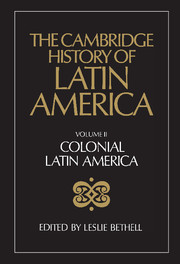Book contents
- Frontmatter
- PART ONE POPULATION
- PART TWO ECONOMIC AND SOCIAL STRUCTURES: SPANISH AMERICA
- PART THREE ECONOMIC AND SOCIAL STRUCTURES: BRAZIL
- 12 Colonial Brazil, c. 1580–c. 1750: plantations and peripheries
- 13 Indians and the frontier in colonial Brazil
- 14 Colonial Brazil: the gold cycle, c. 1690–1750
- 15 Late colonial Brazil, 1750–1808
- PART FOUR INTELLECTUAL AND CULTURAL LIFE
- Bibliographical essays
- References
12 - Colonial Brazil, c. 1580–c. 1750: plantations and peripheries
from PART THREE - ECONOMIC AND SOCIAL STRUCTURES: BRAZIL
Published online by Cambridge University Press: 28 March 2008
- Frontmatter
- PART ONE POPULATION
- PART TWO ECONOMIC AND SOCIAL STRUCTURES: SPANISH AMERICA
- PART THREE ECONOMIC AND SOCIAL STRUCTURES: BRAZIL
- 12 Colonial Brazil, c. 1580–c. 1750: plantations and peripheries
- 13 Indians and the frontier in colonial Brazil
- 14 Colonial Brazil: the gold cycle, c. 1690–1750
- 15 Late colonial Brazil, 1750–1808
- PART FOUR INTELLECTUAL AND CULTURAL LIFE
- Bibliographical essays
- References
Summary
SUGAR AND SLAVES
‘A sugar mill is hell and all the masters of them are damned’, wrote Father Andrés de Gouvea from Bahia in 1627. Time and time again observers who witnessed the roaring furnaces, the boiling cauldrons, the glistening black bodies and the infernal whirling of the mill during the 24-hour day of the sugar safra, or harvest, used the same image of hell. Along with mining, the production of sugar was the most complex and mechanized activity that Europeans carried out in the sixteenth and seventeenth centuries, and its ‘modern’ and industrial nature shocked its pre-industrial observers. Yet it was from this nightmarish scene that the society and economy of Brazil grew. During the century from 1580 to 1680 Brazil was the world's largest producer and exporter of sugar. It was in the context of plantation agriculture and sugar that colonial society was formed. Like the sugar-loaf itself, society crystallized with white Europeans at the top, tan-coloured people of mixed race receiving lesser esteem, and black slaves considered, like the dark panela sugar, to be of the lowest quality.
By the final decades of the sixteenth century Brazil no longer resembled the trading-fort establishments of the Portuguese West African and Asian colonies. The shift from private to royal initiative in the exploitation and settlement of the vast Brazilian coastline, the creation of the captaincy system in the 1530s, the subsequent establishment of royal control in 1549, the elimination and enslavement of Indian peoples and the transformation of the principal economy from dyewood cutting to sugar-cane agriculture were all central elements in the colony's formation.
- Type
- Chapter
- Information
- The Cambridge History of Latin America , pp. 421 - 500Publisher: Cambridge University PressPrint publication year: 1984
References
- 1
- Cited by



